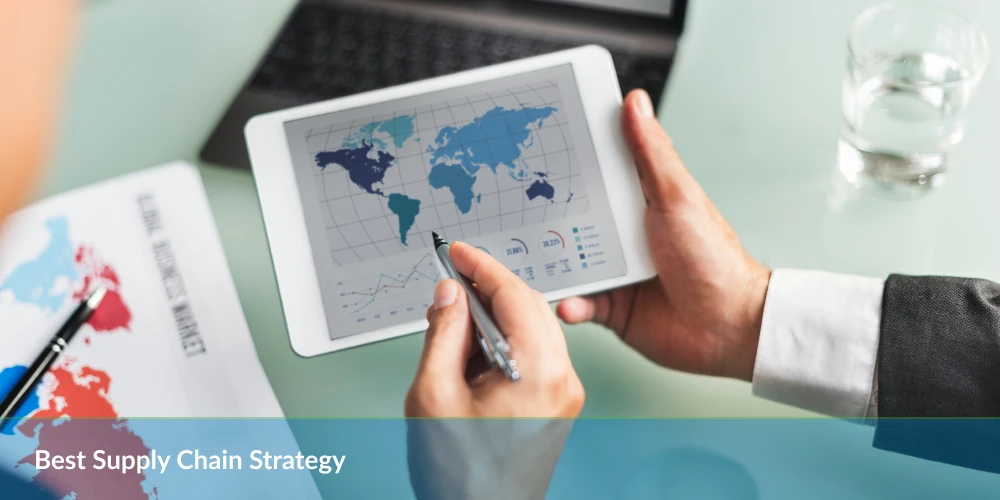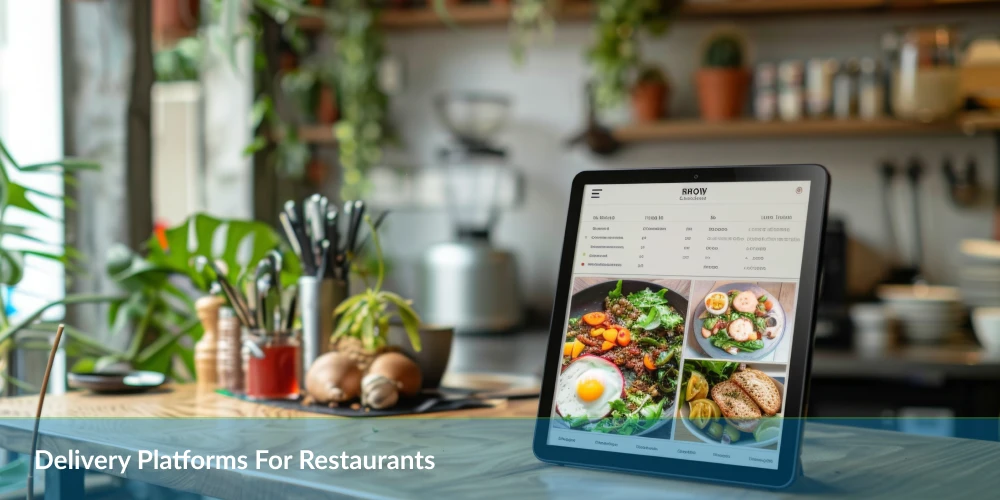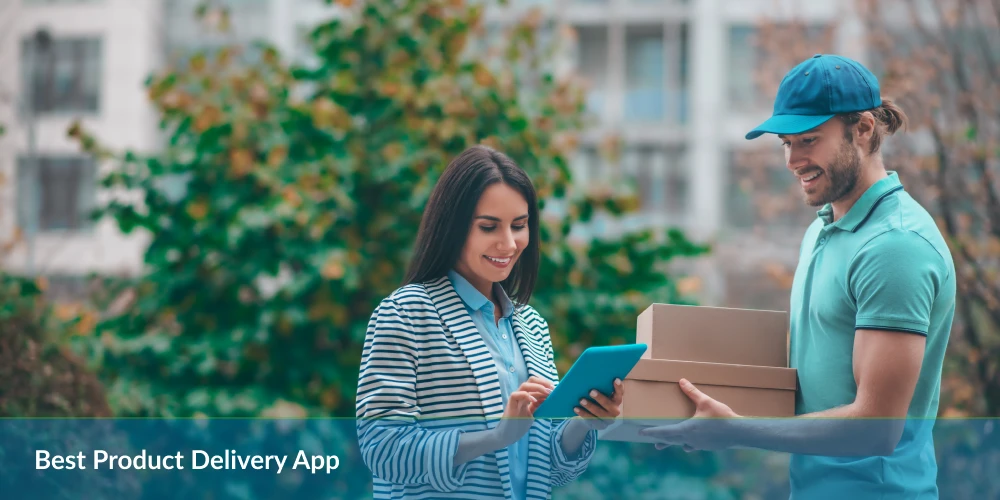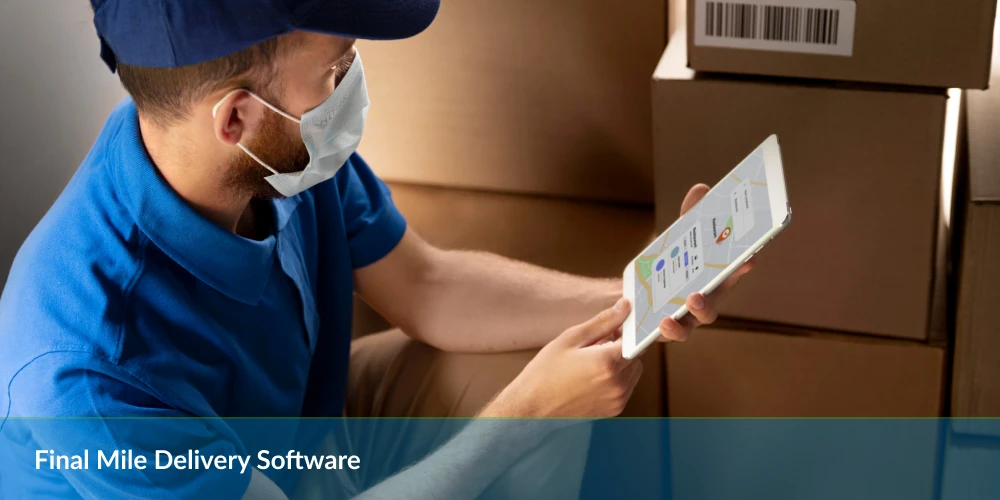Table of Contents
“Generative AI, Multimodal AI, and Copilot AI are transforming the supply chain ecosystem.”
– Dr Firoze Zia Hussain (CSO, Delivery)
Behind every successful e-commerce brand lies an invisible engine that keeps everything running smoothly: the supply chain. It’s not flashy like your homepage, nor as exciting as your product reveal. But get it wrong, and suddenly, your brand’s five-star reviews turn into a flood of complaints. Cart abandonment rates climb. Repeat purchases vanish.
Whether you’re a budding DTC brand or scaling your way into enterprise-level operations, crafting the best supply chain strategy for your e-commerce business is no longer optional; it’s a survival.
Today’s customers expect more than just product availability. They expect instant shipping updates, accurate delivery ETAs, easy returns, and seamless service at every touchpoint. The ability to deliver speed, scalability, and satisfaction isn’t just a competitive edge—it’s the new baseline.
In this guide, we go beyond the basics and dive deep into the nuances of modern e-commerce logistics. From warehouse automation to last-mile efficiency, we’ll explore the pillars of a bulletproof supply chain strategy tailored for e-commerce. Let’s get started.
Understanding the Modern E-commerce Supply Chain
58% of businesses view supply chain management as a competitive advantage in 2024.
Source: Deloitte
A traditional supply chain followed a linear progression, where products moved in a straight path from the manufacturer to the distributor, then to the retailer, and finally to the end consumer. This model was predictable, relatively simple, and based on bulk shipments with long lead times and limited feedback loops.
However, the rise of e-commerce has dramatically disrupted and transformed this conventional framework. Today’s supply chains are no longer linear; in fact, they are dynamic, multidirectional networks driven by real-time data and consumer demand. E-commerce platforms empower consumers to order directly from manufacturers or third-party sellers, often bypassing traditional retail intermediaries altogether. This shift demands faster, more agile fulfillment processes and has intensified the need for last-mile delivery optimization, reverse logistics (returns), and personalized customer experiences.
In this new model, supply chains must be more flexible and responsive, integrating digital technologies like AI, IoT, and predictive analytics to adapt to fluctuating demand patterns and ensure timely delivery. Inventory management has also become decentralized, with products often stored in multiple fulfillment centers or even local hubs to enable same-day or next-day delivery.
Ultimately, e-commerce has not just turned the traditional supply chain on its head—it has redefined it as a responsive, consumer-centric ecosystem that thrives on speed, data, and innovation.
A single sale on your Shopify store kicks off a flurry of backend activities such as inventory validation, warehouse picking, packaging, shipping label generation, and last-mile delivery. When you multiply that by hundreds or even thousands of daily orders, the need for a well-orchestrated supply chain strategy becomes crystal clear.
Your supply chain is more than just an operational necessity; it acts as a silent brand ambassador that either delights or disappoints customers after the purchase. A seamless delivery experience builds trust, increases customer retention, and encourages positive reviews. On the other hand, delays, inaccuracies, or poor communication can damage your brand’s credibility and push customers toward competitors.
In today’s fast-paced e-commerce environment, investing in supply chain excellence is not optional. It is a core component of your customer experience strategy and a key driver of long-term business growth.
Core Components of a Successful Supply Chain Strategy
A successful supply chain strategy is the backbone of efficient operations and exceptional customer experiences. It ensures that products move seamlessly from origin to destination while balancing cost, speed, and quality. In today’s competitive landscape, a strong strategy can be the difference between growth and stagnation. Let’s explore the core components that make it work.
Efficient Planning and Demand Forecasting
High-performing supply chains start with meticulous planning. Accurate demand forecasting reduces inventory costs, prevents stockouts, and aligns production with customer needs. According to McKinsey, companies using AI-driven forecasting can cut supply chain errors by 20–50% and reduce lost sales and stockouts by up to 65%.
Implementing machine learning models, leveraging historical sales data, and integrating external factors, such as seasonality, promotions, or geopolitical events, into predictions ensures better alignment with real-world demand shifts.
Real-Time Inventory Control and Optimization
Real-time visibility into stock levels, locations, and movements drives responsive supply chain operations. Systems like RFID, Internet of Things (IoT) sensors, and cloud-based inventory management platforms deliver continuous updates across the value chain. This level of precision enables swift resource reallocation, minimizes overstock, and accelerates turnover.
- Automated reorder points adjust stock replenishment based on live demand data.
- Safety stock levels dynamically recalibrate according to supply lead times and service level targets.
- Multi-echelon inventory optimization balances stock across warehouses and distribution centers.
Seamless Coordination with Suppliers and Partners
Strong supplier collaboration enables synchronized planning, procurement, and problem resolution. Vendor Managed Inventory (VMI), collaborative forecasting platforms, and digital Supplier Relationship Management (SRM) tools support transparent, data-driven interactions. Embedded communication workflows, automatic alerts, and shared dashboards create unified visibility and reduce time to resolution when issues arise.
Agile Transportation and Fleet Management Systems
Flexibility in logistics execution mitigates delivery delays and cost overruns. Transportation Management Systems (TMS) that incorporate AI routing, real-time GPS tracking, and predictive maintenance maximize efficiency.
Load consolidation tools minimize empty miles and maximize asset utilization.
- Carrier performance tracking benchmarks service levels and penalizes underperformance.
- Real-time exception management flags delays before they affect downstream operations.
Integrated Warehouse Automation Processes
Automation in warehouse operations slashes labor costs, enhances accuracy, and speeds up fulfillment. Robotics, Automated Guided Vehicles (AGVs), and warehouse execution systems support high velocity and low error rates—even during volume spikes. Research by Zebra states that- “ To ease workloads, 64% of decision-makers plan to adopt mobile or automation solutions within five years. While 21% aim for partial automation, 10% will fully automate, and just 5% will stick with paper-based systems.”
Combine pick-to-light systems, smart conveyors, and real-time workforce allocation to shorten fulfillment cycles and improve labor efficiency metrics such as orders picked per hour.
Data-Driven Decision-Making Using KPIs and Analytics
Success metrics guide strategy execution and course correction. Leading organizations track KPIs like Inventory Turnover, Order Accuracy Rate, Perfect Order Rate, and Cash-to-Cash Cycle Time at granular levels. Embedded analytics platforms digest operational data, visualize trends, and trigger automated responses to deviations.
What’s your Inventory Days on Hand trend over the last six months? How does supplier On-Time-In-Full (OTIF) performance compare by region? Analytics answers these questions before they evolve into bottlenecks.
Pro Tip: Leverage real-time data and automation across your supply chain to boost efficiency, reduce costs, and stay ahead of disruptions.
The Three Pillars of the Best Supply Chain Strategy
Modern consumers demand near-instant gratification. With companies like Amazon setting the gold standard for fast, often free delivery, customer expectations have dramatically shifted. Today, whether you’re a DTC brand or an omnichannel retailer, delivering products quickly is no longer a competitive advantage—it’s a baseline expectation.
A. Strategies for Speed:
- Distributed Warehousing: Strategically place fulfillment centers near your largest customer bases to shorten delivery distances. This reduces last-mile costs and enables quicker order fulfillment.
- Zone Skipping: Consolidate shipments and move them directly to destination zones before handing them over to local carriers, eliminating multiple sorting steps and expediting delivery.
- Route Optimization: Use AI and machine learning tools to analyze traffic patterns, delivery windows, and fleet performance. Optimized routes lead to faster deliveries and lower fuel costs, especially in congested urban areas.
Pro Insight:
Micro-fulfillment centers—compact, automated urban warehouses—are gaining popularity for enabling same-day or next-day delivery without the overhead of large distribution centers. These facilities bring products closer to the consumer, ensuring faster turnaround while maximizing space and cost-efficiency.
B. Scalability: Building for Growth Without Breaking Operations
E-commerce growth is rarely linear. Sudden demand spikes—whether from a viral campaign, seasonal promotion, or market expansion—can strain even the most robust supply chains. A scalable supply chain absorbs growth without causing breakdowns in quality, speed, or customer service.
How to Scale Efficiently:
- Leverage 3PLs (Third-Party Logistics): Collaborating with providers like NetworkON, ShipBob, Flexe, or Red Stag enables rapid geographic expansion, without the need to invest in warehousing, staffing, or shipping infrastructure. These partners offer plug-and-play scalability.
- Adopt Modular Software Solutions: Cloud-based systems for inventory management, order tracking, and customer communications are flexible and grow with your business. APIs and integrations allow for seamless additions as needs evolve.
- Automate Warehouse Operations: Introducing robotics, pick-to-light systems, smart shelving, and conveyor belts ensures that your warehouse can process higher order volumes with greater speed and fewer errors. Automation not only boosts throughput but also improves worker safety and job satisfaction.
Key Takeaway:
Scalability is more than handling more orders—it’s about managing increased complexity, maintaining accuracy, and sustaining brand performance during rapid growth.
C. Satisfaction: Delivering a Brand Experience, Not Just a Box
Your supply chain is an extension of your brand. It’s not just about getting a package from point A to point B—it’s about how that package gets there, how it looks when it arrives, and how easy it is for the customer to interact with your brand post-purchase. A poor delivery experience can quickly erase the goodwill built through marketing, while a great one builds trust and loyalty.
Ways to Improve Customer Satisfaction:
- Branded Tracking Pages: Replace generic carrier tracking with custom-branded pages that reflect your voice, visuals, and product recommendations. It keeps customers engaged and reinforces your brand identity during the shipping process.
- Accurate Delivery Estimates: Avoid overpromising and underdelivering. Provide ETAs based on real-time inventory levels and carrier performance, and proactively communicate delays when they occur.
- Easy Returns: Simplify the return process by automating return label generation, offering multiple drop-off options, and keeping customers informed every step of the way. A seamless return experience can turn a disappointed buyer into a repeat customer.
Remember: Your product might be great, but if it arrives late, damaged, or without updates, the customer remembers the frustration, not the item. A thoughtful, customer-first delivery experience transforms logistics into a lasting brand differentiator.
Choosing Between In-House Fulfillment vs 3PLs
As your business scales and order volumes grow, a pivotal question arises: Should you invest in building your own in-house fulfillment infrastructure or partner with a third-party logistics (3PL) provider?
This decision can significantly impact your operational efficiency, customer satisfaction, and long-term profitability. Owning your fulfillment operations offers control, brand consistency, and potentially lower costs at scale. However, it also requires substantial upfront investment in warehouses, technology, and labor. On the other hand, outsourcing to a 3PL provides flexibility, faster market expansion, and reduced overhead, allowing you to focus on growth and core competencies.
Carefully weighing the trade-offs between cost, control, scalability, and customer experience is essential to choosing the right path for your supply chain strategy.
| Criteria | In-House Fulfillment | Third-Party Logistics (3PL) |
| Cost Control | Higher upfront costs, more control | Lower initial cost, pay-as-you-go model |
| Scalability | Slower, needs capital investment | Quick to scale, flexible capacity |
| Customer Experience | Fully customizable | Dependent on the partner’s capabilities |
| Geographic Reach | Limited without multiple facilities | Access to national/international hubs |
Hybrid models also work—use 3PLs in regions where you don’t have a presence, and fulfill in-house in your strongest zones.
Technology: The Backbone of a Winning Supply Chain Strategy
Modern logistics can no longer depend on spreadsheets, siloed systems, or manual guesswork. In today’s fast-paced e-commerce environment, supply chain efficiency relies on real-time visibility, automation, and data-driven decision-making. Integrated technology stacks are essential for meeting customer expectations and maintaining operational excellence. The right tools reduce human error, speed up processes, and provide the transparency needed to deliver on time, every time.
Essential Tools for Supply Chain Optimization
1. Warehouse Management System (WMS)
A WMS improves efficiency by automating tasks like receiving, picking, packing, and restocking. It ensures accurate inventory tracking and streamlined workflows, which reduces fulfillment time and labor costs.
Top platforms include NetSuite WMS, Fishbowl, and Manhattan Associates.
2. Order Management System (OMS)
An OMS manages the end-to-end order lifecycle. It handles tasks such as order routing, splitting, inventory synchronization, and backorder management. A reliable OMS ensures consistent performance across multiple sales channels and locations.
3. Inventory Management Software
This software enables real-time inventory tracking and accurate forecasting. It helps businesses avoid both overstocking and stockouts by analyzing historical sales data and external factors like seasonality and promotions.
4. Shipping and Carrier Optimization Tools
Shipping software simplifies rate comparisons, label generation, delivery tracking, and return processing. It helps businesses select the best carriers based on cost, speed, and reliability, improving customer satisfaction.
By integrating these technologies, businesses can build a responsive, scalable, and resilient supply chain. This technology foundation supports long-term growth, reduces operational risks, and ensures a consistent customer experience. Let me know if you’d like to add examples, visuals, or a summary statement.
Last-Mile Delivery Optimization: Final Touch in Customer Satisfaction
Congested streets, unpredictable traffic patterns, limited parking, and stringent regulatory environments define the urban delivery landscape. These factors increase delivery times, reduce fleet efficiency, and elevate operational costs. In cities like New York and London, last-mile delivery can account for 30% to 50% of the total logistics cost. Without targeted strategies, logistical bottlenecks intensify, and customer satisfaction drops.
Companies now deploy strategies including geofencing for optimized routing, consolidated delivery windows to reduce truck rolls, and dynamic delivery scheduling. For example, UPS uses a system called ORION (On-Road Integrated Optimization and Navigation), which leverages advanced algorithms to eliminate unnecessary left-hand turns and streamline millions of deliveries each day.
Micro-Fulfillment Centers and Delivery Hubs for Faster Service
Speed remains the primary driver of customer satisfaction in last-mile delivery. To shrink the gap between order placement and doorstep delivery, many retailers introduce micro-fulfillment centers (MFCs) and urban delivery hubs. These localized nodes dramatically cut delivery times by positioning inventory closer to consumers.
Walmart launched its first automated MFC in 2019, powered by Alert Innovation’s Alphabot system, enabling store-level fulfillment with rapid order picking. Meanwhile, Amazon has developed a network of same-day delivery stations designed to handle hyperlocal order volumes, improving its Prime fulfillment promises.
- Micro-fulfillment centers: Typically operate within 10,000 to 20,000 square feet and use automation to process thousands of SKUs quickly.
- Urban delivery hubs: Function as aggregation points for couriers, enabling bike and foot deliveries in dense city zones.
Using Customer Data to Offer Flexible Delivery Options
Personalization in delivery services is not a premium perk—it’s an expectation. Leveraging customer data enables organizations to tailor delivery windows, unlock preferred delivery locations, and provide real-time tracking. This flexibility shapes the final impression of the entire shopping experience.
Companies like DPD and FedEx integrate predictive analytics to recommend delivery times based on historical customer behavior. Carrefour, a French multinational retailer, uses customer order and location data to propose two-hour delivery windows, increasing success rates for first-attempt deliveries and tightening operational efficiency.
Interactive delivery management portals, SMS alerts, and live delivery adjustments are powered by backend systems analyzing preferences, repeat buying patterns, and regional delivery trends. Why does this matter? Because 73% of consumers say delivery is the most important experience when shopping online, based on a 2023 PwC Global Consumer Insights Pulse Survey.
Pro Tip: Use customer data and local fulfillment hubs to personalize delivery options and reduce last-mile delays, as this directly improves customer satisfaction.
In e-commerce, product returns are a common reality, especially in industries like apparel, electronics, and home goods. While many businesses view returns as a challenge, successful brands recognize them as an opportunity to create a positive customer experience and stand out in a competitive market. A seamless, hassle-free return process can increase trust, improve customer satisfaction, and even encourage repeat purchases.
Key Strategies to Optimize Reverse Logistics
1. Offer Pre-Paid Return Labels
Make the return process easy by providing a pre-paid label with the original shipment or allowing customers to download one from their account. This step removes friction and encourages customers to shop with confidence.
2. Enable Smart Return Portals
Implement an online return system that lets customers initiate returns on their own. These portals can collect feedback, allow return reason selection, and guide customers through the process, providing real-time updates and additional options like exchanges or store credits.
3. Automate Inventory Reconciliation
Use automated tools to speed up the inspection and restocking of returned items. Faster reconciliation reduces warehouse clutter, minimizes losses, and ensures that popular items become available for purchase again quickly.
Pro Tip:
Brands that offer transparent and flexible return policies often experience higher customer loyalty and increased repeat business. Turning returns into a smooth experience can transform a logistical challenge into a powerful customer service advantage.
Sustainability and Green Logistics: Building for the Future
Reducing greenhouse gas emissions starts with smarter transportation systems. Route optimization algorithms, when applied at scale, significantly cut fuel consumption and drive time. According to the U.S. Department of Energy, planning optimal routes helps maximize vehicle efficiency by reducing miles driven, stops at signals, time spent in traffic, and the number of vehicles needed for routes.. This impact scales quickly when applied across national or global distribution networks.
Pairing this with electric vehicle (EV) fleets amplifies environmental gains. Companies like Amazon and UPS have already deployed thousands of EVs, and results show clear environmental and cost benefits. For instance, Amazon aims to deploy 100,000 electric delivery vans through its partnership with Rivian, forecasting millions of metric tons in emission reductions over the lifetimes of these vehicles.
Urban areas with low-emission zones further accelerate the shift. EVs avoid regulatory penalties and benefit from access to restricted city centers, enabling both compliance and speed. Combining real-time traffic data, EV range modeling, and dynamic scheduling ensures maximum asset utilization with minimal environmental impact.
Packaging Smarter, Managing Returns Intelligently
Packaging contributes more to a supply chain’s carbon footprint than many expect. Right-sizing packaging cuts waste, transportation costs, and material usage. For example, according to Talk Business & Politics, Walmart’s use of software to optimize box size reduced cardboard use by 7.2 million pounds in a single year.
Switching to biodegradable materials, eliminating excess air in packages, and moving away from single-use plastics drives impact. But efficiency doesn’t stop at outbound logistics. Reverse logistics plays a critical role.
Product returns in e-commerce can exceed 20% of total sales. Without a sustainable reverse logistics system, these returns generate unnecessary emissions and landfill waste. Circular practices such as refurbishing, resale, and sustainable disposal lower ecological costs and recapture value. Apple’s trade-in programs and use of recycled material in new product assembly illustrate how reverse flows can generate both revenue and sustainability gains.
Aligning Green Practices with Customer Expectations
Consumer expectations have shifted. According to a 2023 NielsenIQ study, 78% of U.S. consumers value sustainability, and over 60% are willing to pay more for eco-friendly products. This consumer stance transforms green logistics from a compliance requirement into a brand differentiator.
Brands with deeply embedded sustainability practices often benefit from stronger customer loyalty, higher retention rates, and increased advocacy. Patagonia, for instance, integrates sustainability into every layer of its supply chain, which reinforces a loyal customer base willing to pay premium prices for responsibly produced goods.
Certifications and transparent reporting—such as CO2 emission disclosures, Science Based Targets, and third-party environmental ratings—reinforce credibility. When sustainable logistics aren’t just adopted but actively communicated, they become a powerful asset in competitive positioning.
- Route optimization cuts fuel use by up to 20% across operations.
- EV fleet deployment reduces regulatory costs and emissions.
- Eco-packaging lowers material waste and logistics costs simultaneously.
- Reverse logistics recaptures value and curbs landfill contributions.
- Sustainable practices directly increase brand trust and consumer loyalty.
Key Takeaways
- Speed, Scalability, and Satisfaction Define Supply Chain Success
A responsive supply chain must deliver quickly, grow effortlessly, and provide a seamless experience that earns customer trust.
- Technology Is the Backbone of Modern Logistics
Integrated tools like WMS, OMS, and real-time inventory systems streamline operations, reduce errors, and keep customers informed.
- Reverse Logistics Enhances Customer Loyalty
A smooth return process supported by smart portals, pre-paid labels, and fast reconciliation transforms returns into a brand-building moment.
- Sustainable Supply Chains Build Brand Value
Eco-friendly packaging, electric fleets, and green returns are more than compliance, they’re a direct response to consumer demand for responsible commerce.
Conclusion
In today’s e-commerce landscape, the supply chain is more than just backend infrastructure. It is a customer-facing engine that drives loyalty, repeat purchases, and long-term revenue. Every touchpoint in the delivery process reflects on your brand’s reliability and values.
Here’s what sets a successful supply chain apart:
Speed helps you meet growing customer expectations for rapid delivery.
Scalability keeps your operations flexible and efficient as your business expands.
Satisfaction turns one-time buyers into loyal customers through seamless experiences.
Whether you’re fulfilling orders from a small warehouse or coordinating with multiple logistics partners across regions, the fundamentals remain the same. Success depends on your ability to implement the right tools, technology, and strategies to deliver more than just products. A well-executed supply chain delivers trust.
Take control of your delivery operations with NetworkON.
NetworkON provides the real-time visibility, automation, and intelligent routing you need to optimize last-mile logistics. From order assignment to doorstep delivery, we help you create a delivery experience that delights your customers and grows your business.
Ready to upgrade your logistics strategy? Get started with NetworkON today.
Frequently Asked Questions (FAQs)
Q1: Why is last-mile delivery optimization so important in e-commerce?
Last-mile delivery can account for up to 50% of total logistics costs. Optimizing it ensures faster, more reliable service while reducing operational expenses and improving customer satisfaction.
Q2: How does NetworkON help improve delivery operations?
NetworkON offers real-time visibility, route optimization, automation, and smart scheduling to streamline last-mile delivery, reduce delays, and create a more consistent customer experience.
Q3: What’s the difference between using a 3PL and managing fulfillment in-house?
In-house fulfillment offers more control and customization, while 3PLs provide flexibility, lower upfront costs, and easier scalability, especially for geographic expansion.
Q4: How can small businesses implement scalable supply chain strategies?
Start with modular technology, partner with 3PLs, use cloud-based systems, and automate warehouse tasks. These steps allow you to scale without large capital investments.





0 Conversations